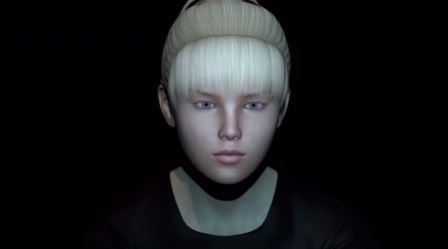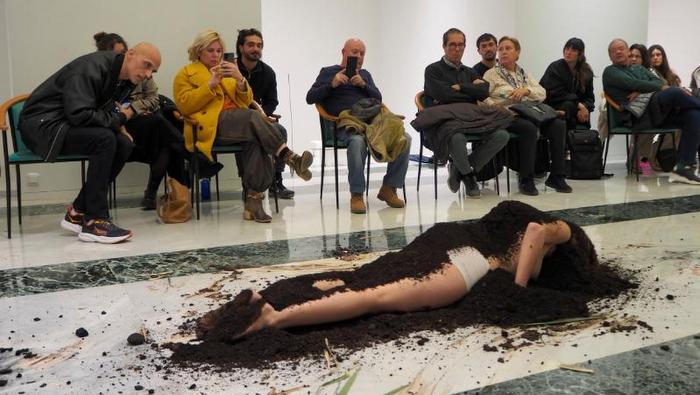By Alyssa Buffenstein
DuoSkin, a new gold-leaf, temporary tattoo that can control your electronics from your skin, has been making headlines this week. “We believe that in the future, on-skin electronics will no longer be black-boxed and mystified,” says the MIT team that developed the technology in collaboration with Microsoft Research. Also in the news is a Virtual Reality/human exoskeleton combo that is helping paraplegics regain feeling and movement, and another VR program that may be able to help prevent the elderly from falling.
Our cyborg future is nearing, and it doesn’t seem so scary. But artists have been imagining this future—where we can exist past the limitations of our physical bodies—for years now, whether by creating digital avatars, exploring online worlds, or reflecting on a post-human state using old-school media.
In the mid 2000s, the 3D virtual world computer game Second Life became a medium for many artists, such as Cao Fei and Jon Rafman. Fei planned cities in the role-playing game as an avatar called China Tracy, a fantasy character through which she could virtually be someone else. Rafman, however, took the online simulation to an extreme, taking viewers on tours through the digital world with the avatar of the “Kool-Aid Man.” Where most users stuck to human- or animal-like avatars, Rafman existed as a corporate-created jug of red liquid with a face. Kool-Aid Man in Second Life proposes the ability of a human user to exist, and act, as an image. More recently, Rafman is making waves with his work with VR headset gaming company Oculus Rift, like international art events at NADA 2014 or the 2016 Berlin Biennale, where he recreates the viewer’s physical surrounding and then morphs and destroys it.
Engaging with the visual tropes of a different online community is artist Andrea Crespo, who is inspired by DeviantArt, an online home to many visual subcultures. Her work, which was shown at Kraupa-Tuskany Zeidler in early 2015 and the Swiss Institute in New York later in the year, fleshes out the characters of Cynthia and Celinde, two avatars who share a body. The exhibition text for the Swiss Institute exhibition posits, “it seems possible the characters exist solely for each other, as though they might have drawn themselves.” Like Rafman, Crespo uses online communities to explore the potentials of post-human identity making, and experiments with creating a sense of independent sentience in her work.
Even more independently digital than Crespo’s Cynthia and Celinde is artist LaTurbo Avedon, who has no ties to a physical human artist at all. She exists only as an avatar, much like the digital pop star Hatsune Miku, with whom she has collaborated. A 2015 work, Browsing, positions the viewer as a computer screen, facing LaTurbo as she appears to idly browse the internet, her face illuminated by an LED glow, her hair and clothing slowly changing colors. We see the virtual artist doing the most mundane of contemporary activities. Her work also comprises of beautifully intricate digital renderings, not tying her exclusively to explorations of the self.
Similarly, in Cecile B. Evans’ What the Heart Wants, a highlight of this summer’s Berlin Biennale, cartoons aren’t stand-ins for humans; instead, they are beings, some human-like, others animated ears, self-aware of their status of bits of data, ruminating on the idea of being human but not longing for it.
Adding a touch of Silicon Valley neurosis to the mix is Ed Fornieles, who has developed a alias of a virtual fox across multiple works. Most recently, at a solo show at Arratia Beer in Berlin, the cute cartoon explored the world of “self-management diets.” Der Geist: Flesh Feast presents the body, via an avatar, as a machine.
But the gravitation towards digital avatars isn’t the full extent of post-human tendencies in art. “Chatsubo,” a summer 2016 show at Kraupa-Tuskany Zeidler, is named after a bar in William Gibson’s 1984 science-fiction novel Neuromancer. In the book that anticipated the Matrix films, body-modified characters can exist in cyberspace, a freedom that prompts the main character to view his physical body as a prison. The exhibition comprised drawings, paintings, and sculptures—notably nothing digital—that explored the idea of body modification and impossible human forms.
Fringe body modification technologies already allow humans to record their biomedical data through an implant, while Silicon Valley biohackers use supplements and biphasic sleep aim to optimize their performance. Biohacking, VR, electronic tattoos, and online forums can all morph the idea of being human. For many people, these technologies can eradicate physical blocks to self-realization. Artists scrutinize these methods from a distance; in the gallery context, human augmentation can be showcased, reflected upon, questioned, and perhaps even expedited.
Source: news.artnet.com















